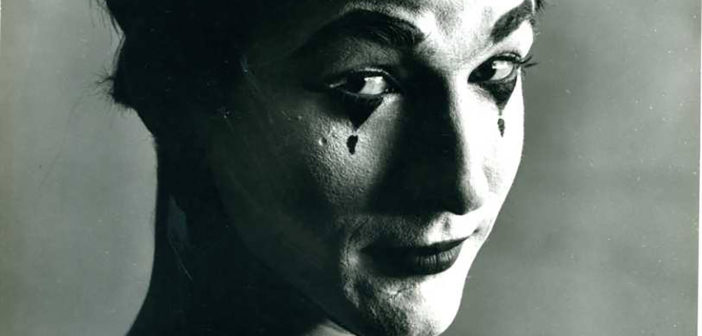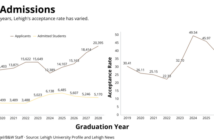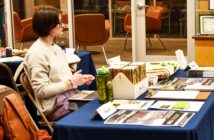In ancient Greece, people rubbed coins against touchstones to determine if the metals were real or fake.
However, the stone holds a deeper meaning for alum Bill George, ’73.
To George and his company co-founders, it represents an intrinsic dedication to virtue, to answer the question of truth. After considering hundreds of names for their company, they landed on Touchstone Theatre.
“Humorous, fun, playful and also interested in truth,” he said. “Touchstone, we thought, embodied that.”
George, an ensemble member and teacher, said Touchstone is unorthodox in its thinking and work.
Since its beginning, George’s creative energy and belief in the importance of body and space in theater has inspired the spirit of the theater’s work. Touchstone performs original, ensemble-created works and reimagines theater locally, nationally and internationally.
“Bill is a mover,” said Jp Jordan, Touchstone’s artistic director. “That’s what he’s trained in — movement. It’s ingrained in the Touchstone Company.”
George said he envisions his physical space as a canvas. He makes it his goal as a performer and artist to write something new and different on his canvas.
The six-member ensemble is committed to working together and using a variety of spaces that influence artistic choices while performing. George said a football field would encourage different decisions than Touchstone’s 72-seat theater would.
“Our work grows out of a tension or interaction between an audience or a particular idea and ourselves and out of that tension, one creates form or story,” George said. “It’s shaped by the space.”
John Pearson, George’s Lehigh professor, largely inspired him. Pearson, with whom George had plans to start a company at Lehigh, died when George returned from receiving his Master of Fine Arts at the Dallas Theater Center. George named Touchstone’s studio theater in his honor.
Pearson led a speech program through Lehigh’s English department and convinced George to get involved in theater. George said he credits his success to his fortune of meeting and working with Pearson.
After Pearson’s death, George formed the People’s Theatre Company in 1977 with several others, including his wife, Bridget, Ricardo Viera of the Lehigh University Art Galleries, and Pearson’s widow, Barbara.
After four years, the People’s Theatre Company transformed into Touchstone Theatre. The group continued to tour around the world performing at colleges and other venues.
Their home office was in South Bethlehem, where the group worked out of George’s garage. He built a stage, insulated the walls, installed a coal stove and kept an office in the kitchen.
Touchstone found its current home at 321 E Fourth St. in 1987. As the company grew, the members noticed a shift in their relationship with the local community. They looked for ways to better connect with South Bethlehem, so they started focusing more on their local audiences.
“Once you have a real concrete base that you can work out of, it gives you much more flexibility and confidence and credibility in the artistic community,” said Dave Fry, ’73, the founder of Godfrey Daniels.
George said he, along with Fry, cartoonist Gene Mater, ’71, and Doug Roysdon of Mock Turtle Marionette Theatre, were involved in a regional movement in which arts migrated into smaller cities and communities, rather than New York City or Los Angeles.
The group of artists brought their crafts to South Bethlehem within a few years of each other.
“I have the attitude that theater is for people and that there’s no one place on earth that’s any more exciting or meaningful than any others,” George said. “And there was a need for art here.”
Even after living and traveling around the world to countries such as Japan, Switzerland and Argentina, George’s love for South Bethlehem remained. He said the community boasts ethnic variety, beautiful architecture from the height of the steel business, and great grit.
Fry, who was a part of Touchstone in the ’80s, said South Bethlehem also provided an opportunity with cheaper buildings and a lack of present art to grow the roots of their businesses. Mater, George’s fraternity brother in Lehigh’s chapter of Theta Chi, also said Bethlehem is home to many open-minded people looking for new experiences.
“We could produce shows, have failures and not lose the house,” Fry said. “That’s the beauty of the South Side.”
Mater said their artistic movement to South Bethlehem was not a collective decision — they all pursued their own ideas, put down roots and grew their companies into what they are today.
George’s creativity comes from a spirituality that flows through everything that he does, and Fry said this spirituality is matched by his craft and his advocacy for the arts, small theater, community involvement and “arts that matter.”
“He’s trying to knock down the precepts, he’s trying to change the ambient approach to theater and he’s trying to involve the community,” Mater said. “Going after something just because it’s there to be done, there’s a nobility to that, and I think his life speaks of a certain nobility.”






Comment policy
Comments posted to The Brown and White website are reviewed by a moderator before being approved. Incendiary speech or harassing language, including comments targeted at individuals, may be deemed unacceptable and not published. Spam and other soliciting will also be declined.
The Brown and White also reserves the right to not publish entirely anonymous comments.
1 Comment
Nice to see Bill and Touchstone are still around. Thanks for the piece.